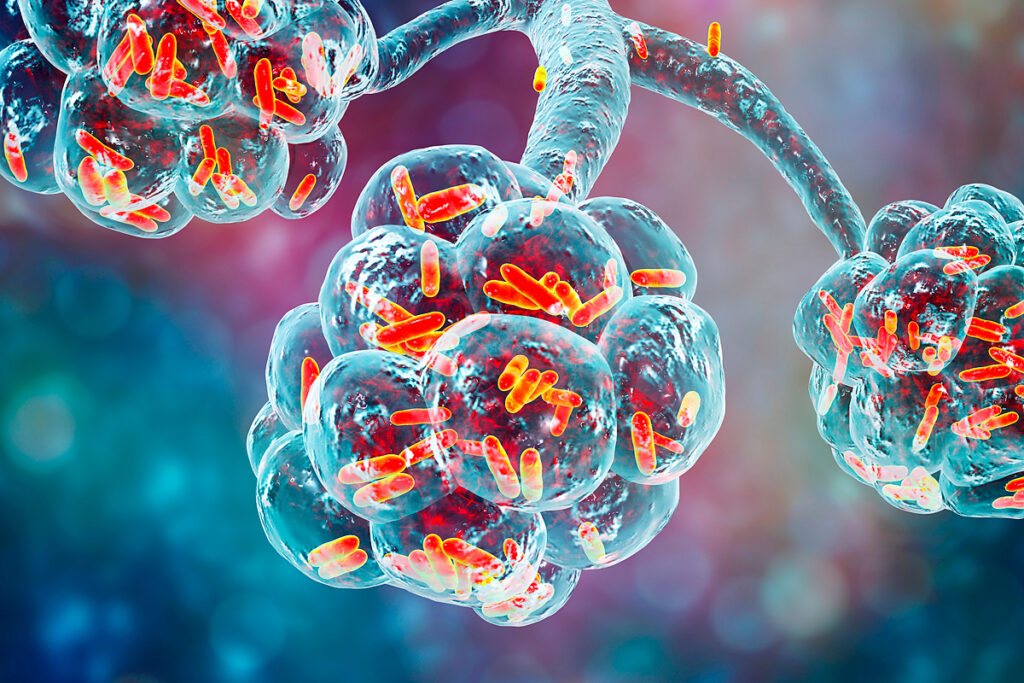The relationship between humans and bacteria is very different. Some bacteria are helpful for humans: they help to digest food, stimulate the immune system, and protect against harmful effects. Other bacteria-neutral for health: they live on our skin and do not interfere. And still, others cause diseases of varying severity.
The interferon system functions (IFN) in protecting humans from bacterial infections are ambiguous, poorly understood, and remain largely mysterious. Interferons can increase or decrease the disease depending on the type of bacterium, the disease stage, the path of infection, or the body’s characteristics.
Content
- Interferon for bacterial pneumonia caused by Klebsiella pneumoniae
- Interferon for bacterial pneumonia – legionellosis
- Interferon for Helicobacter pylori infection
- Interferon for chlamydial infection and bacterial vaginosis
- Interferon for salmonellosis
- Interferon for tuberculosis
- References
Interferon for Bacterial Pneumonia Caused by Klebsiella Pneumoniae
Type I interferons are required to protect the lungs from bacterial pneumonia. Scientists from the UK have confirmed this with the example of the bacterium Klebsiella pneumoniae, which causes severe pneumonia, sepsis and urinary tract infections.
Lung protection during K. pneumoniae infection is promoted by Mucosal-associated invariant T (MAIT). MAIT are non-traditional T-lymphocytes that can quickly detect pathogens in the respiratory mucosa and protect tissue integrity during bacterial and viral infections.
Type I IFNs drive the activation and antimicrobial function of MAIT cells during bacterial pneumonia. It was previously thought that the activation of MAIT cells during bacterial infections was the mechanism of antigen presentation. Scientists from the UK have shown that this is not the case. However, IFN-I is necessary and sufficient for MAIT cell activation. In K. pneumoniae infection, type I interferon stimulates MAIT cells to migrate from the lung parenchyma to the spaces near the bronchi and produce proteins responsible for cytotoxic functions. These proteins help kill infected cells and protect against bacterial pneumonia.
Details of the study are in the article “Type I Interferons are Required to Protect Against Bacterial Pneumonia.” The study was published in the Journal of Experimental Medicine.
Interferon in legionellosis
Legionnaires ‘ disease is a severe form of pneumonia caused by a bacterium of the genus legionella. The bacteria enter the phagocytes and form a unique formation – a vacuole hidden from the phagocyte’s protective system.
In 2009, a team of scientists from the United States and Austria demonstrated in a series of studies that the interferon system suppresses infection. In one experiment, scientists showed interferon type 2 (IFN-2) promotes nitric oxide production, destroying the vacuole and killing bacteria.
In 2016, an international team of scientists from Germany, the UK, Switzerland, and Australia continued to investigate the role of IFN in Legionnaires ‘ disease. Scientists have discovered another mechanism of the interferon system to suppress legionella. It was found that type 1 interferons (IFN-1) stimulate the production of itaconic acid in the infected cell. Itaconic acid has a bactericidal effect for legionella.
The researchers suggest that interferon drugs will be effective in fighting drug-resistant bacteria.
Interferon for Helicobacter Pylori Infection
Helicobacter pylori is a bacterium that is the leading cause of chronic gastritis, peptic ulcer, and stomach cancer. Helicobacter pylori causes chronic infection in nearly half of people.
To protect against the immune system, Helicobacter blocks interferon signals in the epithelial cells of the stomach:
- In response to infection with the bacterium Helicobacter, immune cells of macrophages produce type I interferon. IFN-I molecules attract other immune cells – lymphocytes and dendritic cells – to the site of infection. IFN-I stimulates the production of inflammation-causing proteins to fight the bacteria.
- To protect against inflammation and avoid an immune response, the Helicobacter bacterium deprives the stomach’s epithelial cells of the opportunity to receive the interferon signal and produce antibacterial proteins.
- As a result of the work of the protective mechanism, an area of reduced inflammation, a smaller number of immune cells and antibacterial defense proteins is formed in the lesion. This area is where the Helicobacter bacteria live. At the same time, in neighboring areas where the epithelium is healthy, on the contrary, there is increased inflammation and a high concentration of immune cells.
Details of the study – in the article “Helicobacter Isolates Interferon Out of The Immune System.” The study was published in the Journal of Immunology Research.
Another mechanism for protecting Helicobacter from the immune system is associated with the synthesis of interferon molecules and not with signaling, as in the previous case:
- Probiotic bacteria stimulate immune cells to produce interferon-beta – under the influence of probiotics, the synthesis of IFN-β increases by 400 times.
- Helicobacter pylori produces VacA toxin, which blocks the production of IFN-β stimulated by probiotics and thus prevents the launch of adaptive immunity—adding Helicobacter pylori to probiotic bacteria at a concentration of 1:1 blocks the production of IFN-β.
- The negative effect of Helicobacter is leveled by the pre-treatment of immune cells with a probiotic for 3.5 hours. From a concentration of probiotic bacteria to Helicobacter 16:1, interferon-beta production is restored to normal levels.
Details of the review – in the article “How Helicobacter Interferes with Probiotics to Stimulate The Synthesis of IFN-β“.
Helicobacter Pylori Treatment with Recombinant Interferon-α2b
In 2006, scientists from the Russian Center for Functional Surgical Gastroenterology investigated how a systemic preparation of interferon-α2b affects recovery after surgical treatment of chronic gastritis and duodenal ulcer. The study involved 49 people who underwent radical duodenoplasty.
Immunotherapy with systemic IFN-α2b in the early postoperative period reduced the number of Helicobacter bacteria: 3 times in the antrum and five times in the fundus. In both sections, the level of inflammation decreased by two times.
Details of the study – in the article “Helicobacter Isolates Interferon Out of The Immune System.” The study was published in the Russian Medical Journal.
Interferon-gamma Contribute to Protect against Helicobacter Pylori
IFN-γ is necessary to protect against infection with Helicobacter pylori but simultaneously stimulates stomach inflammation when the disease has already occurred.
A 1999 Japanese study on mice confirms this. Mice unable to produce IFN-γ were 30% more likely to be infected with H. pylori than normal mice. However, 15 months after infection, normal mice developed erosions in the gastric epithelium, and mice unable to produce IFN-γ showed no symptoms of inflammation.
Details of the study – in the article “Helicobacter Isolates Interferon Out of The Immune System.” The study is published in the Infection and Immunity journal.
Interferon and chlamydia infection
Chlamydia is a genus of bacteria that most often affects the urogenital system. They disrupt the natural bacterial balance of the mucous membranes and cause urethritis, vaginitis, and vaginosis.
The cells of the body produce interferon in response to the penetration of chlamydia into them. Interferon molecules attract immune cells-phagocytes to the lesion site to destroy bacteria and change the infected cell’s biochemistry to counteract infection.
In 2005, Japanese scientists from Okayama University investigated human interferon’s effect on the growth of chlamydia in epithelial cells. In their experiment, the researchers showed that IFN slows the growth of chlamydia. Under interferon’s influence, the amount of the essential amino acid tryptophan decreases in the infected cell, and without tryptophan, chlamydia cannot reproduce. Also, under the effect of IFN, the availability of iron in the cell decreases, which also prevents infection from developing.
IFN-α reduces the number of chlamydia in infected cells by 52%, reduces their infectivity and inhibits growth. The combination of IFN-α, IFN-γ, and TNF-γ is more effective in treating chlamydia than treatment with either alone.
Details of the study – in the article “Interferon Deprives Chlamydia for Reproduction.” The study was published in the Biomedical Research journal.
Interferon preparations are adequate for the topical treatment of recurrent bacterial vaginosis during pregnancy. Combination therapy with an antimicrobial drug, antibiotic and interferon alfa-2b reduced the number of relapses of bacterial vaginosis in pregnant women by three times. IFN-α2b improved acid-base balance and bacterial composition of the vagina and stimulated antimicrobial immunity. Local application of interferon did not lead to significant side effects requiring discontinuation of the drug.
The article “Interferon-alpha Reduces Recurrent Bacterial Vaginosis Frequency in Pregnant” contains details of the study. The research was published in the journal Obstetrics, Gynecology and Reproduction.
Interferon in salmonellosis
Salmonella is a genus of gastrointestinal bacteria that causes an acute infectious disease-salmonellosis. Salmonella can survive inside immune cells-phagocytes that fight against foreign genetic forms. These bacteria use the IFN system to gain an additional advantage for reproduction. American scientists from the University of Maryland investigated this mechanism.
The researchers observed the development of infection in two types of immune cells. One group of cells was susceptible to the interferon molecules, the other group of cells was not. The experiment showed that immune cells from the first group under the influence of IFN live longer and bacteria actively multiply in them. Such cells die of necrosis, and the bacteria freely come out and infect other cells.
The second group of cells did not perceive IFN signals. In these cells, when infected with salmonella, the process of programmed death was triggered. And not only the cell itself died, but also the bacteria in it. In this case, the infection did not develop.
Scientists suggest that salmonellosis can potentially be treated with antibodies to interferon. The antibodies will help destroy the interferon molecules and prevent the bacteria from multiplying.
Interferon in tuberculosis
Tuberculosis is one of the top ten causes of death in the world. According to the World Health Organization, more people died from tuberculosis in 2019 than from other infections.
Mycobacterium tuberculosis, the causative agent of the disease, destroys the protective programs of phagocytes, makes their intracellular environment suitable for survival, and manipulates the immune response. This mycobacteria strategy complicates the interferon system’s work, so in some cases, IFN suppresses the infection and stimulates in others.
IFN-1 stimulates the development of tuberculosis in sick people and infected people with weakened immunity.
In 2010, scientists from the United States and the United Kingdom studied the blood composition of 393 people with active tuberculosis, latent (latent) form, and healthy volunteers. The study showed that the infected and patients with tuberculosis had increased activity of the IFN-1 genes. Moreover, as the patients were treated successfully, the activity of these genes decreased. Scientists suggest that people with high IFN-1 activity are predisposed to tuberculosis.
This idea is supported by the observations of doctors from Japan, Italy, Brazil, and Israel, who since 2006 have registered cases of the transition of tuberculosis from the latent form to the active state in people treated with IFN-1 for hepatitis C.
A possible reason for this type 1 interferon system is that it suppresses the defense mechanisms against mycobacterium tuberculosis. One of these effects was demonstrated in 2017 by scientists from China and the United States. In a mouse model, the researchers showed that mycobacteria stimulate the activity of IFN-1, which, in turn, prevents the production of proteins that exhibit bactericidal activity.
Scientists suggest that drugs that reduce the production of IFN-1 in the body will be suitable for treating tuberculosis.
IFN-1 contributes to the treatment of tuberculosis in drug-resistant infections and increases the BCG anti-tuberculosis vaccine’s effectiveness.
In 2013, Greek doctors from the Aristotle University of Thessaloniki used IFN-1 to treat a patient with active tuberculosis successfully. The previous 8 months of conventional TB therapy in this patient were inconclusive. The patient recovered 2 months after the combined treatment of IFN-1 with antimycobacterial chemotherapy drugs. During the next 4 years, the patient had no relapses of the infection.
Scientists from different countries are investigating the benefits of IFN-1 when using the BCG anti-tuberculosis vaccine. For example, Mexican scientists in 2017 demonstrated that IFN-1 enhances the protective effect of the BCG vaccine by promoting the production of antimycobacterial molecules.
Useful article, necessary information? Share it!
Someone will also find it useful and necessary:
Sources
- Inhibition of chlamydia trachomatis growth by human interferon-α: mechanisms and synergistic effect with interferon-γ and tumor necrosis factor-α
- Vaginal biocenosis in pregnant women with recurrent bacterial vaginosis after treatment with recombinant human interferon alpha-2b
- Salmonella Typhimurium Co-Opts the Host Type I IFN System To Restrict Macrophage Innate Immune Transcriptional Responses Selectively
- Interferons Direct an Effective Innate Response to Legionella pneumophila Infection
- IFNs Modify the Proteome of Legionella-Containing Vacuoles and Restrict Infection Via IRG1-Derived Itaconic Acid
- Доклад о глобальной борьбе с туберкулезом 2019
- An Interferon-Inducible Neutrophil-Driven Blood Transcriptional Signature in Human Tuberculosis
- The association of interferon with the development of pulmonary tuberculosis
- Deficiency of the AIM2–ASC Signal Uncovers the STING-Driven Overreactive Response of Type I IFN and Reciprocal Depression of Protective IFN-γ Immunity in Mycobacterial Infection
- The effect of combination IFN-alpha-2a with usual antituberculosis chemotherapy in non-responding tuberculosis and diabetes mellitus: a case report and review of the literature
- IFN-α Boosting of Mycobacterium bovis Bacillus Calmette Güerin-Vaccine Promoted Th1 Type Cellular Response and Protection against M. tuberculosis Infection
- Type I interferons drive MAIT cell functions against bacterial pneumonia
- Helicobacter pylori Infection Elicits Type I Interferon Response in Human Monocytes via Toll-Like Receptor 8 Signaling
- Эффективность рекомбинантного интерферона a2b при эрадикации Helicobacter pylori у пациентов с осложненной язвенной болезнью двенадцатиперстной кишки
- Role of Gamma Interferon in Helicobacter pylori-Induced Gastric Inflammatory Responses in a Mouse Model
- Vaginal biocenosis in pregnant women with recurrent bacterial vaginosis after treatment with recombinant human interferon alpha-2b



